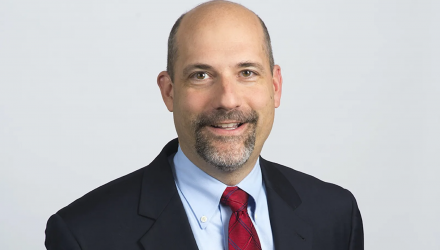The Invesco S&P 500® Equal Weight ETF (RSP) launched 20 years ago, reinventing the ways that investors were able to access the S&P 500.
RSP continues to add value to portfolios, helping mitigate concentration risk with an equal-weight strategy, and has provided the potential for higher returns in a cost-effective and tax-efficient way.
VettaFi’s Editor-in-Chief Lara Crigger and writer Elle Caruso recently sat down with Nick Kalivas, head of factor and core equity product strategy for Invesco, to discuss how RSP came to be, now over 20 years ago.
Caruso: RSP was the first smart beta ETF. What was its impact on the ETF industry?
Kalivas: I think what it did was introduce people to the concept that you don’t have to be so cap-weighted. I think conventional wisdom back in that time was thinking more about cap weighting, and when you went to equal weight, I think it kind of provided a gateway into factor investing.
When you start to think about the implications of equal weight, the fact that now you have a size factor, a little value factor, it helped to facilitate kind of factor investing more generally. So it was something that that kind of laid the groundwork for that and started to democratize different return and risk profiles to the average investor through an ETF.
These strategies were taking place in other avenues. The equal-weight mutual fund has been around longer than the ETF. But I think that putting it in the ETF was something that kind of just helped push the ETF industry forward and got people to think about the usefulness of the ETF wrapper in terms of strategies that have more turnover and are kind of subject to more trading to meet their objective.
See more: Overcome S&P 500 Concentration Risk with RSP
Crigger: 20 years ago, before smart beta ETFs were mainstream, what was the prevailing thought around having these strategies in an ETF wrapper? Was there concern that it just wasn’t the right vehicle for an equal new strategy?
Kalivas: No, I mean, I think it’s just part of the evolution process of the ETF. I would say, to some degree, the natural way for the industry to go or for people to go is thinking about, well, we got the S&P 500. Let’s put it in an ETF. Equal weight was kind of that easy next step. I mean, it’s just the S&P 500 but weighted equally.
I would say it was probably helpful that you had this launch kind of after the tech bubble. Investors were a little, I wouldn’t say disenchanted, but the shortcomings or some of the risks to cap weighting became more present. Investors were looking for alternative ways to get equity exposure and I think equal weight helped to fill that that gap.
You started to get people more interested in commodities or other type of strategies because of the impact of the of the popping of the tech bubble and the effects that it had on returns and the sting that it had towards some of the investors who got caught up in in that euphoria in the in the turn of the late 90s, early 2000s. So I think it really helped to kind of set the environment for people to kind of embrace equal weight and look for other ways to get exposure.
Caruso: Did RSP see a quick adoption among investors? There was already an equal weight mutual fund, right, so how quickly did investors start using RSP?
Kalivas: I would say the growth looked relatively strong given the base that it started off. If you just look at AUM at the end of ’03, it was just short a $200 million. And then in ‘04 you had $485 million in net flows. So it seemed to grow very nicely off the base in the early years and seemed like it had very good acceptance in that time period.
For more news, information, and analysis, visit the Portfolio Strategies Channel.

